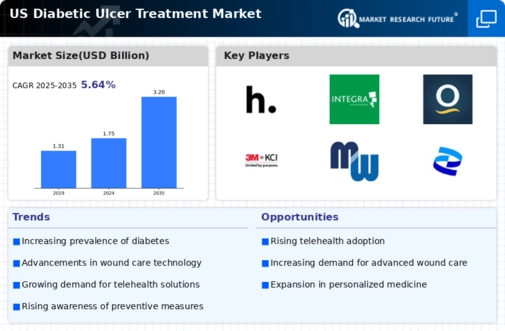Growing Geriatric Population
The aging population in the US is another significant driver for the diabetic ulcer-treatment market. As individuals age, the risk of developing diabetes and related complications, such as foot ulcers, increases. The US Census Bureau projects that by 2030, approximately 20% of the population will be aged 65 and older. This demographic shift is expected to lead to a higher incidence of diabetes and, consequently, a greater need for effective ulcer treatments. Healthcare systems are increasingly focusing on tailored treatment plans for older adults, which may include specialized wound care products. This trend suggests a growing market opportunity for companies that cater to the unique needs of the elderly in managing diabetic ulcers.
Rising Incidence of Diabetes
The increasing prevalence of diabetes in the US is a primary driver for the diabetic ulcer-treatment market. According to the Centers for Disease Control and Prevention (CDC), approximately 34.2 million people in the US have diabetes, which translates to about 10.5% of the population. This growing diabetic population is at a heightened risk for developing foot ulcers, necessitating effective treatment options. As the number of individuals with diabetes continues to rise, the demand for advanced wound care products and therapies is expected to increase correspondingly. This trend indicates a robust market potential for companies specializing in diabetic ulcer treatments, as healthcare providers seek to address the complications associated with diabetes more effectively.
Increased Healthcare Expenditure
Rising healthcare expenditure in the US is likely to bolster the diabetic ulcer-treatment market. The US spends more on healthcare than any other country, with total healthcare expenditure reaching approximately $4.1 trillion in 2020. This financial commitment to healthcare translates into increased funding for diabetes management and ulcer treatment programs. As healthcare providers invest in better treatment options and technologies, patients will have access to more effective therapies for diabetic ulcers. This trend indicates a favorable environment for market growth, as both public and private sectors prioritize funding for innovative solutions in the diabetic ulcer-treatment market.
Advancements in Wound Care Technologies
Innovations in wound care technologies are significantly influencing the diabetic ulcer-treatment market. The introduction of advanced dressings, bioengineered tissues, and negative pressure wound therapy has transformed the management of diabetic ulcers. These technologies not only enhance healing rates but also reduce the risk of infections, which is crucial for diabetic patients. The market for advanced wound care products is projected to grow at a CAGR of around 6.5% through 2027, reflecting the increasing adoption of these technologies. As healthcare providers become more aware of the benefits of these innovations, the diabetic ulcer-treatment market is likely to experience substantial growth, driven by the demand for more effective and efficient treatment solutions.
Emphasis on Patient Education and Awareness
There is a growing emphasis on patient education and awareness regarding diabetes management and ulcer prevention, which is positively impacting the diabetic ulcer-treatment market. Healthcare organizations and advocacy groups are increasingly focusing on educating patients about the importance of foot care and early intervention in preventing diabetic ulcers. This heightened awareness is likely to lead to earlier diagnosis and treatment, ultimately reducing the severity of ulcers and associated complications. As patients become more informed about their condition, the demand for effective treatment options is expected to rise, creating opportunities for companies in the diabetic ulcer-treatment market to expand their reach and improve patient outcomes.




















Leave a Comment